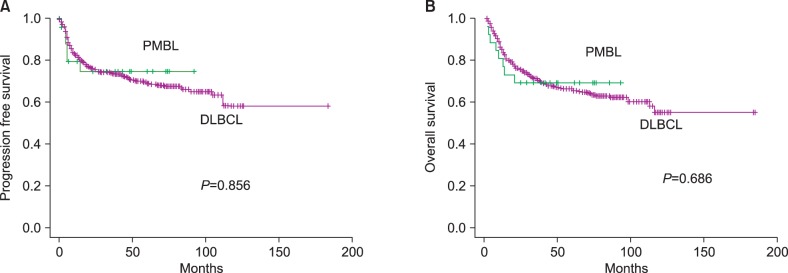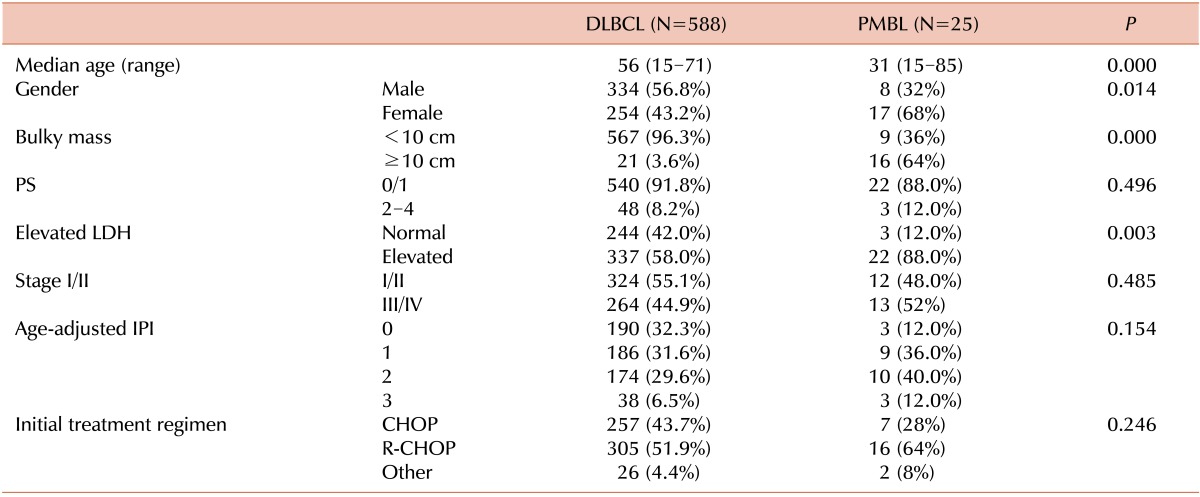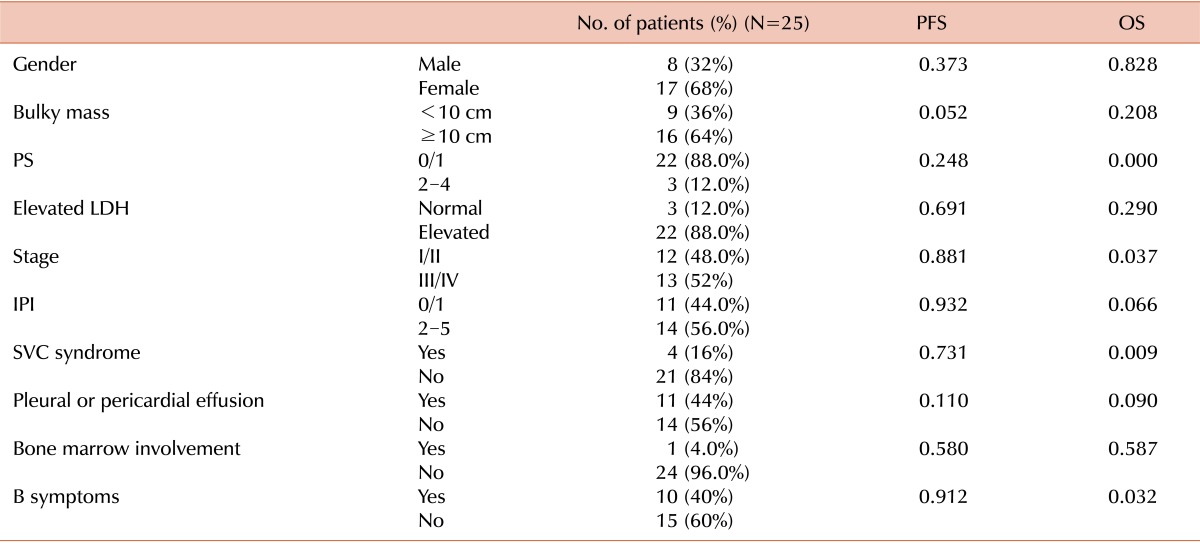Abstract
Background
Primary mediastinal large B-cell lymphoma (PMBL) is a distinct subtype of non-Hodgkin lymphoma, which has no consensus for its ideal treatment or prognosis.
Methods
We reviewed the clinicopathologic features and clinical outcomes of 25 PMBL cases diagnosed at a single institution between 1993 and 2009 and compared them with 588 cases of non-mediastinal, diffuse large B-cell lymphoma (DLBCL, control group) diagnosed during the same period.
Results
Thirteen (52.0%) PMBL patients had Ann Arbor stage III or IV disease, and 10 (40.0%) had B symptoms. Thirteen (52%) PMBL patients were classified as high-intermediate/high-risk according to the International Prognostic Index. There was a significant prevalence of young (median: 31 years; range, 15-78 years; P<0.001), female (68%; P=0.014) patients in the PMBL group compared to the control group (median: 56 years; range, 15-85 years; 43.2% female). Bulky disease and elevated levels of lactate dehydrogenase (LDH) were more frequent in the PMBL group (P<0.001 and P=0.003, respectively). Nineteen (76%) PBML patients achieved complete remission, and 18 were alive at the last follow-up (median: 43 months; range, 1-92 months). There was no difference in the 3-year, overall survival rate (72%, 95% confidence interval [CI]: 54.0-83.0 versus 70.1%, 95% CI, 109.0-126.0; P=0.686) between PMBL and control patients, respectively.
Primary mediastinal large B-cell lymphoma (PMBL), previously classified as a subtype of diffuse large B-cell lymphoma (DLBCL) but recently established as a distinct type of non-Hodgkin lymphoma, arises from thymic B-cells [1, 2]. According to reports from Western countries, patients with PMBL are typically young, with a slight to moderate female patient prevalence, compared to patients with other subtypes of DLBCL [3, 4, 5]. PMBL tumors are usually bulky, and up to 50% of patients have signs and symptoms of superior vena cava (SVC) syndrome. Most cases present as stage I/II, and systemic involvement at diagnosis is rare; however, disseminated disease, especially with multiple sites of extranodal involvement, is frequently seen at relapse [6, 7, 8].
While the clinical presentation of PMBL has been well described, controversy exists regarding the response to therapy and prognosis of patients with PMBL. Whereas some early studies indicated that patients with PMBL have an aggressive clinical course with poor survival when treated with cyclophosphamide, doxorubicin, vincristine, and prednisolone (CHOP) chemotherapy alone [7, 9, 10, 11, 12, 13, 14], recent studies have reported a relatively good response rate and survival [6, 8]. Thus, there is no consensus regarding the most appropriate treatment for PMBL, including whether the addition of rituximab, consolidative involved-field radiotherapy (IFRT), or high intensity chemotherapy has a beneficial role.
The aim of this study was to determine the clinicopathologic characteristics and clinical course of Korean patients with PMBL.
Six hundred and thirteen patients diagnosed with DLBCL between July 1993 and June 2009 were identified in our institutional database. Of these, 25 patients were diagnosed with PMBL according to the following World Health Organization criteria [15]: the presence of a mediastinal mass ≥5 cm in the largest diameter, the absence of large masses in addition to the mediastinal mass, and a histopathologic diagnosis based on tumor morphology and immunophenotyping in the appropriate clinical context. All PMBL cases in this study were CD20 positive by immunohistochemistry.
The medical records and pathologic data of the 25 PMBL patients were reviewed. All patients underwent uniform staging, which included a physical examination; blood cell counts and routine blood chemistries; computed tomography (CT) of the chest, abdomen, and pelvis; and examination of bone marrow aspirate and core biopsy. Clinical features, including age, gender, stage, presence of B symptoms, mediastinal mass size, serum lactate dehydrogenase levels (LDH), extent of extranodal disease, bone marrow involvement, Eastern Cooperative Oncology Group performance status, and International Prognostic Index score [16], were recorded.
All patients were restaged using chest and abdomen CT images according to the revised response criteria [17]. Overall survival (OS) was calculated from the date of diagnosis to the date of last follow-up or death from any cause. Progression-free survival (PFS) was calculated from the date of diagnosis to the date of documented disease progression or death; patients living without progressive disease were censored on the date of their last follow-up visit.
Differences in qualitative variables between the PMBL and non-mediastinal DLBCL groups were compared using the chi-square test or Fisher's exact test. Survival was estimated using the Kaplan-Meier method, and the significance of differences was determined using the log rank test. P-values <0.05 were considered significant. All analyses were performed using the statistical package SPSS version 17.0 (SPSS Inc., Chicago, IL, USA).
We compared the 25 cases of PMBL with the 588 cases of non-mediastinal DLBCL. All 25 PMBL patients presented with a mediastinal mass measuring ≥5 cm and were treated with curative intent. The study group consisted of 17 (68.0%) women and 8 (32.0%) men, with a median age of 31 years (range, 15-78 years). Five (20%) patients were in the first or second decade of life, 11 (44%) were in the third or fourth decade, 5 (20%) were in the fifth or sixth decade, and 4 (16%) were over 70 years old. The control group was comprised of 254 (43.2 %) women and 334 (56.8 %) men, with a median age of 56 years (range, 15-85 years).
All PMBL patients were symptomatic, including B symptoms or dyspnea, at presentation; 16 (64%) cases had bulky disease, and 22 (88%) had elevated LDH levels (a mean of 2.3 times higher than the normal range). Pleural or pericardial effusion fluid was present in 11 patients (44%). Only 1 patient had disease involving the bone marrow. Clinicopathologic features of the study and control groups are summarized in Table 1. Comparison of the clinical parameters of the 2 groups revealed a significant difference in age (P <0.001) and gender (P=0.014), with a prevalence for young, female patients in the PMBL group. In addition, bulky disease and elevated LDH levels were more frequent in the PMBL group (P <0.001 and P=0.003, respectively).
The treatment protocols and clinical courses of the 25 PMBL patients are summarized in Table 2. Twenty-three patients were treated with CHOP chemotherapy. Among them, 16 patients received additional rituximab (375 mg/m2 intravenously; R-CHOP) on Day 1 of treatment. One patient received cyclophosphamide, etoposide, vincristine, bleomycin, methotrexate, doxorubicin, and prednisolone (Vanderbilt chemotherapy), and another patient was treated with etoposide, methylprednisolone, cytarabine, and cisplatin (ESHAP) as an initial chemotherapy. Over a median follow-up time of 43 months (range, 1-92 months), 19 patients achieved a complete response (CR) after initial chemotherapy. Eighteen patients were still alive without any evidence of disease at the last follow-up, and 1 patient died from an unknown cause. The remaining 6 patients achieved a partial response (PR); 5 died of disease progression, and 1 died of chemotherapy-related pneumonia. Three of the 19 patients who achieved a CR received consolidative, high-dose chemotherapy, followed by autologous stem cell transplantation (ASCT). Eight patients were administered consolidative radiotherapy (RT) with a median dose of 36.0 Gy (range, 30.6-45.0 Gy), and 1 patient received consolidation RT followed by ASCT after initial chemotherapy at the discretion of the attending physicians. The remaining 7 patients received no consolidation therapy.
Over a median follow-up period of 43 months, there were no differences in 3-year PFS (74.5% [95% CI, 55.0-85.0] versus 73.7% [95% CI, 113.0-132.0], respectively; P=0.856) or 3-year OS (72% [95% CI: 54.0-83.0] versus 70.1% [95% CI: 109.0-126.0], respectively; P=0.686) between PMBL patients and non-mediastinal DLBCL patients, respectively (Fig. 1).
Performance status, stage, the presence of SVC syndrome, and the presence of B symptoms influenced OS (P <0.001, P=0.037, P=0.009, P=0.032, respectively; Table 3), although they were not significant predictors of PFS. We did not perform multivariate analyses because of the small number of patients and events.
The CR rate of PMBL patients who received CHOP therapy was 85.7% (6/7 patients), compared to 68.7% (11/16 patients) in those given R-CHOP, with 3-year PFS rates of 71.4% and 68.2% (P=0.848), respectively, and 3-year OS rates of 85.7% and 62.5% (P=0.242), respectively. There were no relapses among those who achieved a CR.
The relative frequency of PMBL at our institute was 4.08%, compared to 0.26% in Japan [18] and 9% in southern Switzerland [19]. In our study, there were no differences in the clinical outcomes between patients with PMBL and those with non-mediastinal DLBCL. Earlier studies suggested that PMBL has a less favorable outcome than non-mediastinal DLBCL when treated with CHOP-based chemotherapy regimens, prompting the use of more aggressive, combination chemotherapy programs [12, 13, 14, 20] and strategies incorporating up-front, high-dose chemotherapy with ASCT [21]. In contrast, recent studies indicate that cases of PMBL have survival outcomes similar to those of the more common non-mediastinal disease, if not better [6, 8, 22]. In our experience, PMBL is an aggressive disease with a high frequency of bulky masses that is associated with SVC syndrome or B symptoms. However, patients show a good response to treatment and have survival outcomes equivalent to other DLBCL patients. In this study, we observed no differences in PFS and OS between PMBL patients and patients with non-mediastinal DLBCL, which is in agreement with recent reports.
We found that performance status, stage, the presence of SVC syndrome, and the presence of B symptoms each influenced OS. Some studies report that extension of disease into the adjacent thoracic viscera, the presence of pleural or pericardial effusion, and poor performance status are associated with poor prognosis [3, 4, 6]. Our study also showed the presence of pleural or pericardial effusion to be associated with a tendency toward poor prognosis; however, significance was not reached, most likely because of the small number of patients.
The most popular treatment for PMBL is currently R-CHOP chemotherapy alone or R-CHOP chemotherapy followed by IFRT, although up to 25% of patients fail to respond to treatment. There have been no randomized clinical trials involving IFRT. In a recent update of 40 patients that included more than 50% with bulky disease, event-free survival was 95% and OS was 100%. None of the patients had relapsed, and only 2 underwent consolidative RT [23]. Similarly, among our cohort, none of the patients who achieved a CR after initial treatment relapsed, regardless of whether or not they were given consolidative RT.
Recently, retrospective analyses have suggested that the addition of rituximab to chemotherapy for PMBL is beneficial [24, 25, 26]. In addition, a subgroup analysis of the prospective MabThera International Trial Group trial, in which PMBL was treated with a CHOP-like regimen with or without rituximab, reported a favorable effect of rituximab [27]. This was not the case in our study; the CR rate of CHOP patients was 85.7% (6/7 patients), compared to 68.7% (11/16 patients) for R-CHOP patients. Among the 6 patients who failed to achieve a CR, 5 received R-CHOP, and 1 received CHOP chemotherapy. However, interpretation of these results is likely to be complicated by the higher incidence of advanced disease and B symptoms in the R-CHOP arm, as well as the small number of patients.
In conclusion, PMBL predominantly affects young adults, with a peak incidence in the third and fourth decades of life. Although PMBL patients experienced more signs and symptoms than those with non-mediastinal DLBCL, most likely due to the tumor location and prevalence of a bulky mass, there was no significant difference in survival between the 2 groups. Furthermore, the role of rituximab in the treatment of PMBL needs to be validated in future prospective trials.
References
1. Harris NL, Jaffe ES, Diebold J, Flandrin G, Muller-Hermelink HK, Vardiman J. Lymphoma classification-from controversy to consensus: the R.E.A.L. and WHO classification of lymphoid neoplasms. Ann Oncol. 2000; 11(Suppl 1):3–10. PMID: 10707771.
2. Harris NL, Jaffe ES, Stein H, et al. A revised European-American classification of lymphoid neoplasms: a proposal from the International Lymphoma Study Group. Blood. 1994; 84:1361–1392. PMID: 8068936.
3. Lazzarino M, Orlandi E, Paulli M, et al. Treatment outcome and prognostic factors for primary mediastinal (thymic) B-cell lymphoma: a multicenter study of 106 patients. J Clin Oncol. 1997; 15:1646–1653. PMID: 9193365.

4. Cazals-Hatem D, Lepage E, Brice P, et al. Primary mediastinal large B-cell lymphoma. A clinicopathologic study of 141 cases compared with 916 nonmediastinal large B-cell lymphomas, a GELA ("Groupe d'Etude des Lymphomes de l'Adulte") study. Am J Surg Pathol. 1996; 20:877–888. PMID: 8669537.
5. van Besien K, Kelta M, Bahaguna P. Primary mediastinal B-cell lymphoma: a review of pathology and management. J Clin Oncol. 2001; 19:1855–1864. PMID: 11251018.

6. Savage KJ, Al-Rajhi N, Voss N, et al. Favorable outcome of primary mediastinal large B-cell lymphoma in a single institution: the British Columbia experience. Ann Oncol. 2006; 17:123–130. PMID: 16236753.

7. Hamlin PA, Portlock CS, Straus DJ, et al. Primary mediastinal large B-cell lymphoma: optimal therapy and prognostic factor analysis in 141 consecutive patients treated at Memorial Sloan Kettering from 1980 to 1999. Br J Haematol. 2005; 130:691–699. PMID: 16115124.

8. Todeschini G, Secchi S, Morra E, et al. Primary mediastinal large B-cell lymphoma (PMLBCL): long-term results from a retrospective multicentre Italian experience in 138 patients treated with CHOP or MACOP-B/VACOP-B. Br J Cancer. 2004; 90:372–376. PMID: 14735179.

9. Lazzarino M, Orlandi E, Paulli M, et al. Primary mediastinal B-cell lymphoma with sclerosis: an aggressive tumor with distinctive clinical and pathologic features. J Clin Oncol. 1993; 11:2306–2313. PMID: 8246020.

10. Lichtenstein AK, Levine A, Taylor CR, et al. Primary mediastinal lymphoma in adults. Am J Med. 1980; 68:509–514. PMID: 6892753.

11. Trump DL, Mann RB. Diffuse large cell and undifferentiated lymphomas with prominent mediastinal involvement. Cancer. 1982; 50:277–282. PMID: 7044520.
12. Todeschini G, Ambrosetti A, Meneghini V, et al. Mediastinal large-B-cell lymphoma with sclerosis: a clinical study of 21 patients. J Clin Oncol. 1990; 8:804–808. PMID: 1692089.

13. Haioun C, Gaulard P, Roudot-Thoraval F, et al. Mediastinal diffuse large-cell lymphoma with sclerosis: a condition with a poor prognosis. Am J Clin Oncol. 1989; 12:425–429. PMID: 2801603.
14. Kirn D, Mauch P, Shaffer K, et al. Large-cell and immunoblastic lymphoma of the mediastinum: prognostic features and treatment outcome in 57 patients. J Clin Oncol. 1993; 11:1336–1343. PMID: 8315431.

15. Swerdlow SH, Campo E, Harris NL, editors. WHO classification of tumours of haematopoietic and lymphoid tissues. 4th ed. Lyon, France: IARC;2008. p. 250–251.
16. A predictive model for aggressive non-Hodgkin's lymphoma. The International Non-Hodgkin's Lymphoma Prognostic Factors Project. N Engl J Med. 1993; 329:987–994. PMID: 8141877.
17. Cheson BD, Pfistner B, Juweid ME, et al. Revised response criteria for malignant lymphoma. J Clin Oncol. 2007; 25:579–586. PMID: 17242396.
18. Sekiguchi N, Nishimoto J, Tanimoto K, et al. Primary mediastinal large B-cell lymphoma: a single-institution clinical study in Japan. Int J Hematol. 2004; 79:465–471. PMID: 15239397.

19. Anderson JR, Armitage JO, Weisenburger DD. Epidemiology of the non-Hodgkins lymphomas: distributions of the major subtypes differ by geographic locations. Non-Hodgkin's Lymphoma Classification Project. Ann Oncol. 1998; 9:717–720. PMID: 9739436.
20. Zinzani PL, Martelli M, Bertini M, et al. Induction chemotherapy strategies for primary mediastinal large B-cell lymphoma with sclerosis: a retrospective multinational study on 426 previously untreated patients. Haematologica. 2002; 87:1258–1264. PMID: 12495899.
21. Rodriguez J, Conde E, Gutierrez A, et al. Primary mediastinal large cell lymphoma (PMBL): frontline treatment with autologous stem cell transplantation (ASCT). The GEL-TAMO experience. Hematol Oncol. 2008; 26:171–178. PMID: 18432630.
22. Abou-Elella AA, Weisenburger DD, Vose JM, et al. Primary mediastinal large B-cell lymphoma: a clinicopathologic study of 43 patients from the Nebraska Lymphoma Study Group. J Clin Oncol. 1999; 17:784–790. PMID: 10071267.

23. Dunleavy K, Pittaluga S, Shovlin M, et al. Untreated primary mediastinal B-cell (PMBL) and mediastinal grey zone (MGZL) lymphomas: comparison of biological features and clinical outcome following DA-EPOCH-R without radiation. Ann Oncol. 2011; 22(Suppl 4):134(abst 150).
24. Ahn HK, Kim SJ, Yun J, et al. Improved treatment outcome of primary mediastinal large B-cell lymphoma after introduction of rituximab in Korean patients. Int J Hematol. 2010; 91:456–463. PMID: 20198460.

25. Tai WM, Quah D, Yap SP, et al. Primary mediastinal large B-cell lymphoma: optimal therapy and prognostic factors in 41 consecutive Asian patients. Leuk Lymphoma. 2011; 52:604–612. PMID: 21261504.

26. Savage KJ, Yenson PR, Shenkier T, et al. The outcome of primary mediastinal large B-cell lymphoma (PMBCL) in the R-CHOP treatment era. Blood (ASH Annual Meeting Abstracts). 2012; 120(Suppl):abst 303.

27. Rieger M, Osterborg A, Pettengell R, et al. Primary mediastinal B-cell lymphoma treated with CHOP-like chemotherapy with or without rituximab: results of the Mabthera International Trial Group study. Ann Oncol. 2011; 22:664–670. PMID: 20724576.

Fig. 1
Kaplan-Meier curves showing progression-free survival (A) and overall survival (B) of patients with PMBL and non-mediastinal DLBCL, respectively. DLBCL, diffuse large B-cell lymphoma; PMBL, primary mediastinal large B-cell lymphoma.

Table 1
Clinical characteristics and initial treatment regimens of 588 patients with DLBCL and 25 patients with PMBL.

Table 2
Clinical courses of the 25 PMBL patients.

a)One patient received consolidation RT followed by ASCT.
Abbreviations: PMBL, primary mediastinal large B-cell lymphoma; CR, complete response; RT, radiotherapy; ASCT, autologous stem cell transplantation; CHOP, cyclophosphamide, doxorubicin, vincristine, and prednisolone; R-CHOP, CHOP plus rituximab; Vanderbilt, cyclophosphamide, etoposide, vincristine, bleomycin, methotrexate, doxorubicin, and prednisolone; ESHAP, etoposide, methylprednisolone, cytarabine, and cisplatin.




 PDF
PDF ePub
ePub Citation
Citation Print
Print



 XML Download
XML Download